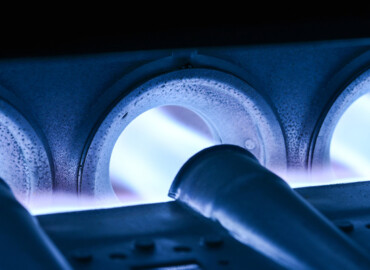How to Clean a Furnace Flame Sensor?
The flame sensor, an essential workhorse of your HVAC system, can just go off while it’s running. Yes, you’ve heard right! After reading this, most of you would be wondering why and how this happens. So, the actual reason behind this is the accumulation of dust, carbon, or dirt on the flame sensor that can occur over time. This could also be the result of being near debris-causing appliances or objects, including pet beds, litter boxes, or clothes dryers.
It’s also easy to make sure and troubleshoot if cleaning is the cause of your problem. Cleaning the flame sensors once a year is recommended to prolong their life and fasten up the functionality of the furnace. To do so, use the steps below to learn how to clean a furnace flame sensor and hold heat to your entire property.
A quick glance at cleaning a furnace flame sensor:
- Disconnect the furnace to the power supply
- Remove the furnace flame sensor carefully
- Clean a dirty flame sensor
- Re-assemble the furnace flame sensor
- Inspect the flame sensor is working properly
- Furnace Flame Sensor: Everything you need to know
A flame sensor, often a simple device or furnace’s power engine, is found in the burner installation. It shares its appearance with a bent, thin, metallic road located in front of the flame stream in the internal part of the furnace. The flame sensor operating at its optimum level means that the HVAC system is assured that the gas valve is open and a flame is indeed present.
But if the gas valve is not catching fire, the sensor will find that there is no active flame, resulting in automatically triggering the furnace to shut down. In most cases, units will be able to power it off three times before going into safety lockout for an hour before trying again.
Tools/Equipment you will need while cleaning furnace flame sensor:
- Wrench or Driver or Screwdriver Set
- Soft bristle brush
- Clean, dry paper towel
- Emery cloth or steel wool
Steps To Clean Furnace Flame Sensor
Step 1: Disconnect the furnace from the power supply
To turn off the power to your furnace, you must first locate the circuit breaker or toggle switch that supplies power to the furnace. It should be mounted in the central power panel or near the furnace, which may appear to be a standard light switch.
Once you reach the circuit breaker or switch, turn it off safely to disconnect the power to the furnace. Typically, furnaces have power shut-off switches near them that look like toggle or light switches.
The furnaces are estimated to have had relevant breakers installed that could have shut them down. If you find that the gas valve is not electrically operated, you will need to shut off the gas to the unit before working on it. If you wouldn’t succeed in finding the power-off switch, we suggest going to the electrical panel and checking the furnace breaker.
Note: Before starting work on the furnace, it is advisable to double-verify that the power is off with a power multimeter. And if the information provided is not of much use to your furnace unit, it is recommended to call an HVAC specialist to repair the unit.
Step 2: Remove the furnace flame sensor carefully
In the next step, you’ll need to remove the flame sensor. To do this, first, find the sensor. Typically, it is attached to the unit near the burners and is secured with a 5/16 or ¼ inch hex head screw. Use a head nut screwdriver to separate the fixing screw that tightens the sensor securely in its position.
After removing the retaining screw or nut, carefully pry the sensor out of its positive and remove it from the furnace. Meanwhile, pay attention not to damage the furnace or sensor. In some scenarios, you may need to cut off the cable for the flame sensor to enable hassle-free cleaning.
Step 3: Clean a dirty flame sensor
With the help of the aforementioned steps, carefully take off the flame sensor from your furnace. The next step you need to conduct is to clean it. After removing the flame sensor, you will need to clean the metal rod, except the ceramic tube, gently. To do so, use a soft cloth, emery cloth, or soft bristle brush. Along with this, use some electrical contact cleaner or rubbing alcohol.
To remove any debris or dirt over the sensor, perform gentle scrubbing. Once it is done, use a neat cloth to dry it thoroughly. Be careful not to use abrasive objects or harsh cleaning compounds, as these can cause wear and tear. After a gentle cleaning, you should reattach it to the furnace unit. Next, inspect it to make sure it is working adequately. Make sure to avoid harsh cleaning, as things can get worsen.
Step 4: Re-assemble the furnace flame sensor
To reconnect the flame sensor, carefully fix the sensor back into position in the furnace. Once the sensor is in position, use a nut driver to loosen the retaining screw or bolt. Keep the screw or nut securely in place. But don’t try to over-tighten it, as it may cause the sensor to explode.
After securely affixing the sensor, re-attach the power cable and inspect if it is working adequately. Also, be sure to check the resistance of the cable going from the flame sensor to the power board to confirm that the wire isn’t damaged.
Step 5: Inspect the flame sensor is working properly
It may be possible that your furnace may take a little extra time to start up. Or the fan turns on immediately and runs for a while. Don’t worry; this is normal after cleaning.
By turning it off at power, it can be reset and operated through a short series of inspections before trying to ignite it. After completing all the steps, your unit will finally start working as before. All you have to do is turn on the smart thermostat on command.
Simply put, Test by turning on the furnace and inspecting the burners. Once this is done, the unit should operate the burners and maintain a steady flame. If the flame is slow or does not catch fire in the burner, the cause may be other parts of the furnace of the flame sensor. At that point, it may be better to call a professional to evaluate and repair the unit.
Tip: To ensure whether or not the furnace flame sensor is working at its optimum level, use a multimeter. By using this device, you can assess the continuity of the sensor. The more continuously the flame sensor operates, the better its efficiency.
Things to keep in mind:
- Even after cleaning, if your flame sensor does not work, the sensor may be broken rather than dirty. In this case, you need to change it.
- To buy the right flame sensor, you are suggested to contact a local supply house or the manufacturer of the unit you own. You just need to look for your unit’s serial number and model to match the accurate sensor rod.
Final Words:
A dirty flame sensor will adversely affect the performance of your cooling and heating system while not being able to deliver the results you want. For furnace service work, hiring an HVAC specialist ensures that the job, no matter how complex, will be done perfectly. When it comes to cleaning, you do not need to call them as it is a straightforward and simple process you can do yourself with the abovementioned steps.




